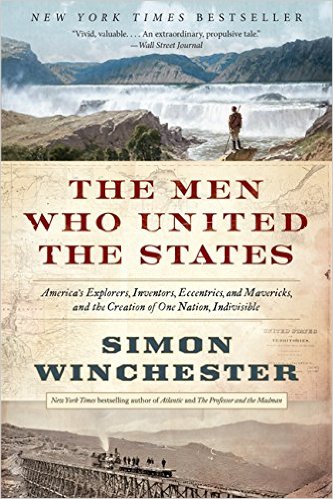|
Simon Winchester books are always rewarding. One of them even helped enlighten me about family history.
He’s on tour right now for his latest book, “Pacific.” I’ve been a fan since we met as reporters following the Irish prime minister around New York, oh, a few years back. I mentioned to our son that I had met Winchester a long time ago, so David bought me a copy of Winchester’s 2013 book, “The Men Who United the States,” about the travelers and builders and visionaries who tied the huge country together with roads, trains and electricity. That book made me realize, all over again, how little I know about American history. I’ve been on hills and rivers in Appalachia that George Washington had explored as a surveyor and soldier and president. I had never read much about Lewis and Clark, how they explored the west – sometimes even splitting up into two parties and meeting further west, all without the help of a GPS, kids. But there was one footnote that really intrigued me. There it is, bottom of Page 19. Before Lewis, before Clark, a “Connecticut opportunist” named John Ledyard had dreamed of walking North America – from west to east, starting in Russia, for goodness’ sakes. I had never heard of Ledyard, but I do know the name. The maternal branch of my wife’s family has long roots in Ledyard, Conn., where a Quaker offshoot, the Rogerenes, settled in the 17th Century. We sometimes stop off in Ledyard, on runs to Boston or Providence, to visit the old Quakertown cemetery (on Col. Ledyard Highway) and pay our respects to Grandpa and Grandma Grundy, and cousin Faith, who put up a good fight but died way too young. Turns out, the town is named after John’s uncle, William Ledyard, who became an officer in the Revolution and in 1781 was murdered by an English officer after handing over his sword. John Ledyard, ever the maverick, maintained his British loyalties, and eventually joined the British navy and served on the second Pacific voyage of Captain Cook. I was hooked, so I ordered up a copy of “Ledyard: In Search of the First American Explorer,” by Bill Gifford. What a life. Ledyard was a Dartmouth student who defied authority, hyperactive or bipolar or whatever the modern term is, but also smart and handsome and randy. Bored in college, he got in a canoe and paddled downriver on the Housatonic, essentially never stopping. Years later he charmed Thomas Jefferson, the ambassador to Paris, into subsidizing his dreamed exploration of the American continent. He mooched off everybody and he walked, often by himself, being known by the description of “traveler.” He never made it to Alaska although he got close, until Catherine, empress of Russia, decided he was a spy, and ordered him expelled – to Poland. He died in Cairo, quite likely from excesses. It’s not the first time Winchester (now an American citizen) has expanded my horizons. Before I went to Seoul for the 1988 Olympics, I read his book, Korea: A Walk Through the Land of Miracles, about his hiking through the mountains. I loved South Korea and its people and their passion for hiking before I ever got there. I’ll catch up with “Pacific” – including the footnotes. 11/10/2015 09:03:47 pm
George Comments are closed.
|
Categories
All
|











